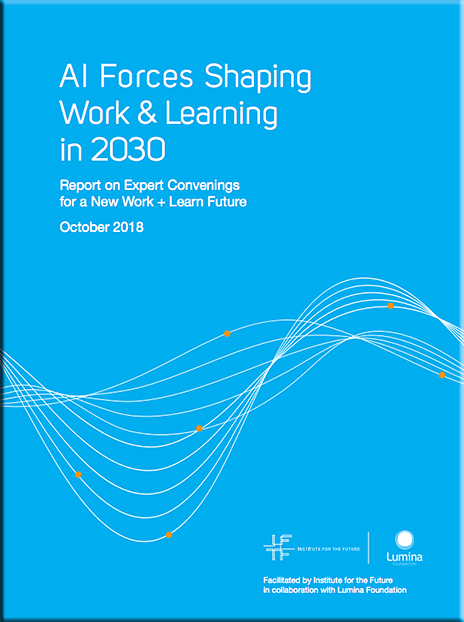What will be important in the learn and work ecosystem in 2030? How do we prepare? — from evolllution.com by Holly Zanville | Senior Advisor for Credentialing and Workforce Development, Lumina Foundation
Excerpt:
These seven suggested actions—common to all scenarios—especially resonated with Lumina:
- Focus on learning: All learners will need a range of competencies and skills, most critically: learning how to learn; having a foundation in math, science, IT and cross-disciplines; and developing the behaviors of grit, empathy and effective communication.
- Prepare all “systems”: Schools will continue to be important places to teach competencies and skills. Parents will be important teachers for children. Workplaces will also be important places for learning, and many learners will need instruction on how to work effectively as part of human/machine teams.
- Integrate education and work: Education systems will need to be integrated with work in an education/work ecosystem. To enable movement within the ecosystem, credentials will be useful, but only if they are transparent and portable. The competencies and skills that stand behind credentials will need to be identifiable, using a common language to enable (a) credential providers to educate/train for an integrated education/work system; (b) employers to hire people and upgrade their skills; and (c) governments (federal/state/local) to incentivize and regulate programs and policies that support the education/work system.
- Assess learning: Assessing competencies and skills acquired in multiple settings and modes (including artificial reality and virtual reality tools), will be essential. AI will enable powerful new assessment tools to collect and analyze data about what humans know and can do.
- Build fair, moral AI: There will be a high priority on ensuring that AI has built-in checks and balances that reflect moral values and honor different cultural perspectives.
- Prepare for human/machine futures: Machines will join humans in homes, schools and workplaces. Machines will likely be viewed as citizens with rights. Humans must prepare for side-by-side “relationships” with machines, especially in situations in which machines will be managing aspects of education, work and life formerly managed by humans. Major questions will also arise about the ownership of AI structures—what ownership looks like, and who profits from ubiquitous AI structures.
- Build networks for readiness/innovation: Open and innovative partnerships will be needed for whatever future scenarios emerge. In a data-rich world, we won’t solve problems alone; networks, partnerships and communities will be key.
Also see:









